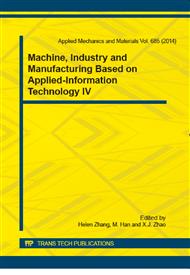[1]
Raymond M. Brach,R. Matthew Brach. A Review of Impact Models for Vehicle Collision. SAE Paper. No. 870048. 1987: 3-7.
DOI: 10.4271/870048
Google Scholar
[2]
Bruce Hongola, Cheng-Yao Chan. Simulation and Animation Tools for Analysis of Vehicle Collision: SMAC(Simulation Model Automobile Collisions)and Carmma (Simulation Animations). California PATH Working Paper. ISSN: 1055—1417. 1999: 3-5.
Google Scholar
[3]
Cheng—Yao Chan. Studies of Vehicle Coll isions—A Documentation of the Simulation Codes: SMAC(Simulation Model of Automobile Collisions). California PATH Working Paper. ISSN 1055—1417. 1998: 2-7.
Google Scholar
[4]
Mchenry B. G., Mchenry R . R. SMAC97 - refinement of the Collision –algorithm. SAE Paper. No. 970947. 1997: l-3.
DOI: 10.4271/970947
Google Scholar
[5]
Richard P. Howard, John Boomer, Cleve Bare. Vehicle Restitution Response in Low Velocity Collision[J], SAEl993-01-0842, (1993).
Google Scholar
[6]
Mchenry B.G., Mchenry R.R. CRASH 97-refinement of the Trajectory Solution Procedure. SAE Paper. No. 970949. 1997: 2-4.
DOI: 10.4271/970949
Google Scholar
[7]
James A. Neptune, James E. Flynn. Impact Analysi s Based upon the CRASH Damage Algorithm. SAE paper. No. 950358. 1995: 1-2.
Google Scholar
[8]
Kenneth. Campbell. Energy Basis for Collision Severity. SAE Paper. No. 740565. 1974: l-4.
Google Scholar
[9]
Mchenry R.R. Mchenry B.G.A. Revised Damage Analysis Procedure For The CRASH Computer Program. SAE Paper. No. 86 1894. 1986: l-2.
DOI: 10.4271/861894
Google Scholar
[10]
Marcus Hiemer, Sebastian Lehr, Uwe Kiencke. A Fuzzy System to Determine the Vehicle Yaw Angle. SAE Paper. No. 2004-01-191. 2004: 1-9.
DOI: 10.4271/2004-01-1191
Google Scholar
[11]
Strother C E, Woolley R L, James M B. A comparison between NHTSA crash test data and CRASH3 frontal stiffness coefficients[C]. SAE, 900101, (1990).
DOI: 10.4271/900101
Google Scholar
[12]
James A N, Crush stiffness coefficients, restitution constants, and a revision of Crash3&SMC[C]. SAE 980029, (1998).
DOI: 10.4271/980029
Google Scholar
[13]
Hermann Steffan B.C. Geile. A New Approach to Occupant Simulation through the Coupling of PC-Crash and MADYMO. SAE Paper. No. 1999-01-0444. 1999: l-5.
DOI: 10.4271/1999-01-0444
Google Scholar
[14]
Michael S. Varat, Stein E. Husher. Crash Pulse Modeling for Vehicle Safety Research. The 18"PESV Paper. No. 50 1. 200 1: 1-5.
Google Scholar
[15]
A. Moser, Steffan,G. Kasanieiey, The Pedestrian Model in PC-Crash the introduction of a Multi Body System and its Validation SAE 1999-01-1445.
DOI: 10.4271/1999-01-0445
Google Scholar
[16]
Hermann Steffan B.C. Geigl, Anoteas Moser,A. New Approach of Occupant Simulation through Coupling of PC-Crash and MADYMO. SAE 1999-01-0444.
DOI: 10.4271/1999-01-0444
Google Scholar


